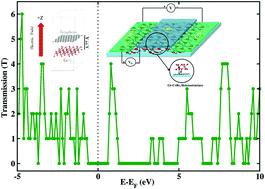Proximity effects in graphene and ferromagnetic CrBr3 van der Waals heterostructures†
Abstract
Herein, we report first-principles calculations for the magnetic proximity effect in a van der Waals heterostructure formed by a graphene monolayer, induced by its interaction with a two-dimensional (2D) ferromagnet (chromium tribromide, CrBr3). We observed that the magnetic proximity effect arising from the spin-dependent interlayer coupling depends on the interlayer electronic configuration. The proximity effect results in the spin polarization of the graphene orbital by up to 63.6%, together with a miniband splitting of about 73.4 meV, and 8% enhancement in the magnetic moment (3.47 μB per cell) in the heterostructure. The position of the Fermi level in the Dirac cone is shown to depend strongly on the graphene–CrBr3 interlayer separation of 3.77 Å. Consequently, we also show that a perpendicular electric field can be used to control the miniband spin splitting and transmission spectrum. Also, the interfacial polarization effect due to the existence of two different constituents reinforces the conductivity via electrostatic screening in the heterolayer. These findings point towards the application potential of this unique system in nanoscale devices, where the electric field-driven magnetic proximity effect can lead to spin controllability and possible engineering of spin gating.



 Please wait while we load your content...
Please wait while we load your content...